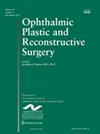眶周静脉内大叶化脓性肉芽肿:一例病例报告和这一奇特病理的文献综述。
IF 1.2
4区 医学
Q3 OPHTHALMOLOGY
Ophthalmic Plastic and Reconstructive Surgery
Pub Date : 2024-09-10
DOI:10.1097/iop.0000000000002778
引用次数: 0
摘要
静脉内小叶化脓性肉芽肿(ILPG)是一种在眼部整形和眼眶文献中鲜有记载的病理。本研究旨在通过病例介绍和文献综述,阐明眶周静脉小叶化脓性肉芽肿的临床表现和组织病理学发现。我们描述了一名 42 岁男性的眶周皮下可触及结节,后经免疫组化确诊为 ILPG。我们以 "眶周静脉内小叶化脓性肉芽肿"、"眶周静脉内化脓性肉芽肿 "或 "眶周静脉内毛细血管瘤 "为关键词,在PubMed/MEDLINE数据库中搜索文章,进行了文献综述。文献综述发现有 6 名患者出现类似的皮下结节,被诊断为眶周静脉内化脓性肉芽肿。包括本研究中的患者在内,所有患者都接受了局部切除治疗。只有 1 名患者(1/7;14.3%)出现疼痛,而 5 名患者(5/7;71.4%)出现肿胀或波动。在有病理报告记录的患者中,所有ILPG均累及角静脉(6/6;100%)。在切除术后 2 至 7 年随访的 3 位患者中,无一复发。组织病理结果显示,这是一种由毛细血管、内皮细胞和周细胞组成的血管内分叶状肿瘤。在毛细血管结构中发现了抗Wilms肿瘤1型(WT-1)和抗平滑肌肌动蛋白的明显反应。ILPG可作为眼周皮下肿块的鉴别诊断依据。虽然眶周ILPG的病因不明,但大多数病例都可以通过手术切除治疗,而且复发似乎并不常见。通过分享这些病例以及眶周ILPG的组织病理学基础,我们试图为眼部整形和重建外科医生描述这种特殊的病理。本文章由计算机程序翻译,如有差异,请以英文原文为准。
Periorbital Intravenous Lobular Pyogenic Granulomas: A Case Report and Literature Review of This Peculiar Pathology.
Intravenous lobular pyogenic granuloma (ILPG) is a seldom-documented pathology in oculoplastic and orbital literature. This study aims to elucidate the clinical presentation and histopathologic findings surrounding periorbital ILPG through a case presentation and literature review. We describe a 42-year-old male with a palpable periorbital subcutaneous nodule that was subsequently diagnosed as ILPG on immunohistochemistry. A literature review was performed by searching articles in the PubMed/MEDLINE database using the keywords "periorbital intravenous lobular pyogenic granuloma," "periorbital intravenous pyogenic granuloma," or "periorbital intravenous capillary hemangioma." The literature review identified 6 patients presenting with similar subcutaneous nodules that were diagnosed as periorbital ILPGs. All patients, including the one in this study, were treated with local excision. Only 1 patient (1/7; 14.3%) noted pain while 5 experienced swelling or fluctuance (5/7; 71.4%). In patients with documented pathology reports, all ILPGs involved the angular vein (6/6; 100%). Of the 3 patients who had follow-ups at 2 to 7 years postexcision, none had recurrence. Histopathologic findings demonstrate an intravascular lobular tumor composed of capillaries with endothelial cells and pericytes. Marked reactivity to anti-Wilms tumor type 1 (WT-1) and anti-Smooth muscle actin was noted in the capillary structure. ILPG can be included on the differential for well-circumscribed, subcutaneous periocular masses. While the etiology of periorbital ILPG is unknown, most cases are managed with surgical excision, and recurrence appears to be uncommon. In sharing these cases and histopathologic underpinnings of periorbital ILPG, we endeavor to describe this peculiar pathology for oculoplastic and reconstructive surgeons.
求助全文
通过发布文献求助,成功后即可免费获取论文全文。
去求助
来源期刊
CiteScore
2.50
自引率
10.00%
发文量
322
审稿时长
3-8 weeks
期刊介绍:
Ophthalmic Plastic and Reconstructive Surgery features original articles and reviews on topics such as ptosis, eyelid reconstruction, orbital diagnosis and surgery, lacrimal problems, and eyelid malposition. Update reports on diagnostic techniques, surgical equipment and instrumentation, and medical therapies are included, as well as detailed analyses of recent research findings and their clinical applications.

 求助内容:
求助内容: 应助结果提醒方式:
应助结果提醒方式:


